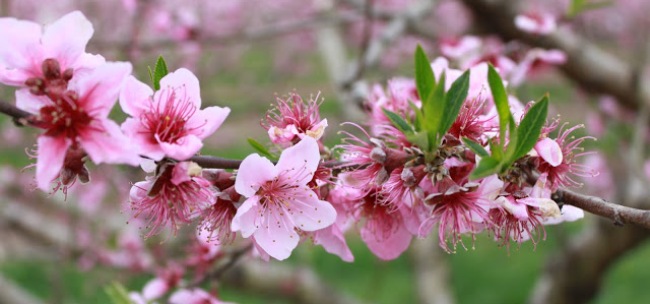Peach Capitol
Fort Valley has a rich and storied history as the Peach Capitol of the World and though the Georgia peach industry is not as large as it once was, Fort Valley remains the Peach State's largest peach producing area.
At one point in its history, there were as many as 50 peach packing houses in and around Fort Valley and "working in peaches" was a rite of passage for young Fort Valleyans. The packing sheds provided thousands of jobs and most of the baby boomers worked in the fields and packing houses in the '60s as the city virtually hummed with activity from early morning to late at night.
Today Fort Valley is home to two very sophisticated packing houses, Lane Southern Orchards and Pearson Farm, and those two facilities pack nearly as many peaches as the 50 packing houses did years ago. The Lane facility is one of the most modern and efficient packing houses in the world and has the capacity to pack and ship 1 million 25 pound cartons of peaches each season. Peaches are generally available mid-May through mid-August. Both sheds offer tours during regular business hours.
Georgia ranks third nationally in acreage devoted to peaches and in production. The Georgia peach crop averaged 86 million pounds per year between 2006 and 2010 and brought in $47 million in 2010.
Peaches were introduced into Georgia in the 18th century, but commercial production did not occur until the mid-19th century. The first Georgia peaches were shipped to the New York market between 1858 and 1860. They were transported by wagon to Augusta, then by shallow-draft boat to Savannah, and finally by steamship to New York. Georgia earned its "Peach State" designation during the three decades following the Civil War.
Considerable expansion of peach acreage occurred in the late 19th and early 20th centuries, resulting in an all-time high production of almost eight million bushels by 1928. Since then production has decreased to about 2.6 million bushels annually.
Samuel Rumph, a middle Georgia peach grower during the early 1900s, revolutionized the peach industry with a new variety which he named after his wife Elberta. This yellow-fleshed peach was of superior quality and shipped better than previous varieties. Elberta remained the leading peach in Georgia until 1960s but newer varieties have since replaced the Elberta in commercial use. Although the Elberta remains the most famous peach name, Georgia now produces more than 40 commercial varieties ... and the Elberta is not one of them.
Founded in 1908 by John David Duke as Diamond Fruit Farm, Lane Southern Orchards farms more than 2,500 acres of peach trees and 2,000 acres of pecans. Located just outside of Fort Valley, the fourth generation family operation now grows more than 30 varieties of peaches. Duke Lane Sr. turned the business over to his four children -- Duke Jr., Bobby, Anne and Steve -- in 1990 and although they sold the business to a large citrus grower from Florida several years fourth and fifth generation Lanes are still involved in management of the company today.
The Pearson family has been growing peaches and pecans for more than 100 years on the same land worked by grandparents of current managing partner Al Pearson. Big 6 Farm is comprised of 1,500 acres of peaches and 2,000 acres of pecans. This family farm produces a bounty of fruit and nuts with the finest being used in Mary Pearson's mail order business, Pearson Farms. The packing house is located about five miles from Fort Valley in the old Zenith school.
Along with the agricultural economy came a demand for chemical fertilizers and pesticides. Woolfolk Chemical Works built a plant in 1920 to manufacture agricultural chemicals in what is now downtown Fort Valley to fill the demand. During the following decades the plant changed hands several times. In the 1980s the Environmental Protection Agency discovered that the ground around the plant was contaminated by lead, arsenic, and other chemicals, and steps were taken to correct environmental damage sustained by the area.
The Atlantic Ice and Coal Co. built a new million dollar ice plant in Fort Valley in 1925 which produced 50,000 tons of ice to cool 17,200 railroad cars filled with peaches. At the time it was built, it was the largest ice plant in the world.
According to local peach grower Bill McGeehee (Big 6 Packing Company), and local historian Wallis Hardeman, the 17,200 railroad cars were the equivalent to about 9,000 truckloads of peaches (one railroad car averaged 400 bushels of peaches). Today growers ship approximately 1,500 to 2,000 truck loads of peaches per year.
In the 1950s and '60s, 400 pound blocks of ice were still used to "hydrocool" (cold water wash) peaches before they were washed, graded, packed and loaded on trucks for shipment. Every local packing house ran trucks to and from the ice plant to constantly replenish the huge hydrocoolers. Modern day refrigerated trucks and railroad cars have eliminated the need for ice houses and hydrocoolers.
Most of the ice plant is still in existence today and it is being used for cold storage. At one time the U.S. government was using the facility to store ready to eat meals (modern day C-Rations). Currently the ice house serves as a cold storage warehouse for peanuts.

